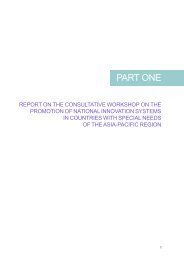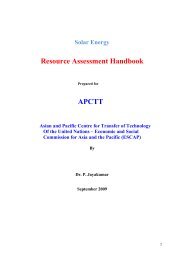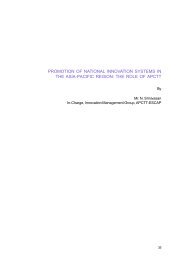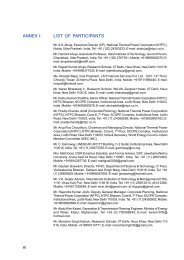up to 1,000 km to store in onshore/offshore geological formations and coal beds thatcannot be mined. It is estimated that there is a worldwide storage capacity of around2,000 billion tonnes of CO 2. Cost may be less by 30 per cent if we take into accountclimate control strategy. CCS is presently in R&D stage, with demo projects planned.In 2009, the Australian government launched the Global CCS Institute to accelerateglobal deployment of CCS.(g) Coal mine methane (CMM)CMM is a large undeveloped resource and its use will reduce GHG emissions. China,Russia, Poland and the United States account for 77 per cent of CMM emissions.According to a 2006 report by the United States Environmental Protection Agency,methane emissions from coal mining will reach 449 million tonnes CO 2eby 2020.Currently only a fraction of CMM is recovered for heat or power production. Powerproduction from CMM has been tried in Australia, Germany, Japan, the United Kingdomand the United States. China, Poland and Ukraine are recent players with 50 projectsrunning worldwide. Motivation for CMM is the Clean Development Mechanism (CDM)defined in the Kyoto Protocol.(h) Underground coal gasification (UCG)The UCG process consists of drilling two production wells, one into the unmined coalseam for injecting the oxidants and the other to bring the gas to the surface. The coalseam, lighted through the first well, burns at temperatures above 1,200°C. Thecombustion generates CO 2, CO and hydrogen, besides minor quantities of methaneand hydrogen sulphide. As the coal depletes on burning, the oxidants are injectedunto the first well to control the burning process. UCG allows access to more of globalcoal resources. In places where mining is uneconomical, the mines could be used toproduce syngas gas through controlled gasification. This may result in an increase ofreserves by 600 billion tonnes worldwide. The United Kingdom, Russia, China, SouthAfrica and New Zealand are the countries attempting this idea.V CONCLUSIONCoal will continue to have a key role in the global energy mix, particularly in light ofChina and India using coal to power their energy requirements for economic growth.Coal provides energy security to these and other emerging economies. It is important,however, that the world attempts to reduce coal’s negative impact while retaining itsbenefits. Clean coal technologies to reduce emissions associated with coal miningand power generation are being developed and deployed around the world. Carbonemissions per kWh generated range from 230 g/kWh for sub-critical plants to lessthan 200 g/kWh for the best available supercritical plant with 45 per cent efficiency.Nevertheless, investments are needed in carbon capture and sequestration as well asother low-carbon technologies in the very near future.As mentioned previously, in India, a proposal to create a National Energy Fund as perthe Integrated Energy Policy is in place. While large public sector enterprises likeBHEL and NTPC are pursuing CCTs, R&D efforts in advanced FFTs are not structuredand no mission-oriented projects have been initiated. There is enormous potential inIndia to develop and deploy advanced technologies to improve not only the efficiency of52
existing power plants but also to build new ones using state-of-the-art technologies.The gap between benchmark technologies and local technology needs to be identified.Materials and technologies for ultra-supercritical plants need to be developed, andsome international players such as GE could play a part in this.There is a large world market for clean coal technologies. Since nearly 40 per cent ofelectricity will still be produced from coal by 2020 this poses great potential for globalsynergy. Advanced FFTs in countries such as the United States, Canada, Australia,Japan and European Union nations need to be assessed for adoption in India. With thevast experience of Indian entities such as NTPC and BHEL, India could effectivelypartner with other developing countries and emerging economies for the deployment ofnew technologies. International consortium of academies such as CAETS can play aproactive role in the development and assessment of new technologies, and internationalorganizations such as WEC and IEA could assist in the adoption of those technologies.VIBIBLIOGRAPHYAnonymous, 2012. “Climate change and renewable energy: IPCC special report onrenewable energy sources and climate change mitigation, 2011”. Akshay Urja,Renewable Energy, Ministry of New and Renewable Energy, vol. 5, issue 4, February2012.Bairiganjan, Sreyamsa and others, 2010. Power to the People: Investing in CleanEnergy for the Base of the Pyramid in India, Centre for Development Finance – WorldResources Institute, Washington D.C., United States of America.Central Electricity Authority (CEA), 2012. National Electricity Plan, Volume 1,Generation. CEA, Ministry of Power, Government of India. Available at http://www.cea.nic.in/reports/powersystems/nep2012/generation_12.pdf.Government of India, 2008. National Action Plan on Climate Change, Prime Minister’sCouncil, Government of India.International Energy Agency (IEA), 2011. World Energy Outlook 2011. IEA, Paris,France. Available at http://www.scribd.com/doc/72512781/World-Energy-Outlook-2011.Kasturirangan, K., 2011. “Science and technology as instruments of faster, sustainableand inclusive development”, 20 th Dr. Amitabha Bhattacharya Memorial Lecture, 15-18December 2011, Institution of Engineers (India), Bangalore, India.Meshram, J.R., 2011. “Biomass power in India - an overview”. Akshay Urja, Ministry ofNew and Renewable Energy, vol. 5, issue 3, December 2011.Ministry of Environment & Forests, 2009. Climate Change and India: Towards Preparationof a Comprehensive Climate Change Assessment, Ministry of Environment & Forests,Government of India.Ministry of Environment & Forests, 2010. Climate Change and India: A 4x4 Assessment,A Sectoral and Regional Analysis for 2030s, Indian Network for Climate ChangeAssessment (INCCA), Ministry of Environment & Forests, Government of India.Ministry of Environment & Forests, 2012. India: Second National Communication tothe United Nations Framework Convention on Climate Change. Ministry of Environment& Forests, Government of India.53
- Page 1 and 2:
ADVANCES IN FOSSIL FUELTECHNOLOGIES
- Page 3 and 4:
ADVANCES IN FOSSIL FUELTECHNOLOGIES
- Page 5 and 6:
CONTENTSABBREVIATIONSiiiPART ONEREP
- Page 7 and 8:
ABBREVIATIONSAC : Alternating curre
- Page 9:
OECD : Organization for Economic Co
- Page 12 and 13: IORGANIZATION OF THE WORKSHOPA. Bac
- Page 14 and 15: D. Election of officersThe followin
- Page 16 and 17: IIICONSIDERATION OF ISSUESA. Backgr
- Page 18 and 19: emissions. Underground coal gasific
- Page 20 and 21: 800 MWe, a steam pressure of 300 kg
- Page 22 and 23: • Materials development & manufac
- Page 24 and 25: Figure 1-5: Strategy for commercial
- Page 26 and 27: tonnes, the state-owned enterprise
- Page 28 and 29: • Ensuring not just easy FDI entr
- Page 30 and 31: MW ultra-supercritical units; and s
- Page 32 and 33: the captive generation capacity) on
- Page 34 and 35: and other financial institutions -
- Page 36 and 37: and higher efficiency power generat
- Page 38 and 39: energy technologies, which can enab
- Page 40 and 41: • Such massive financial inputs c
- Page 43 and 44: BASELINE REPORT ON FOSSIL FUEL TECH
- Page 45 and 46: B. General R&D climate in the count
- Page 47 and 48: a convenient way to envisage energy
- Page 49 and 50: to mature and become more cost-comp
- Page 51 and 52: emissions, at least relative to sin
- Page 53 and 54: The Ministry of Power (MoP), which
- Page 55 and 56: 3. Bio-energyBio-energy, widely ava
- Page 57 and 58: in such a canal will rotate at a lo
- Page 59 and 60: in tackling climate change. A one p
- Page 61: Advantages of supercritical plants
- Page 65 and 66: BASELINE REPORT ON FOREIGN DIRECT I
- Page 67 and 68: CEA at 598 mt. This is mainly due t
- Page 69 and 70: For India to maintain its momentum
- Page 71 and 72: Table 2-5: Electricity generation t
- Page 73 and 74: Growth, which submitted its interim
- Page 75 and 76: 3. Future challengesThe future chal
- Page 77 and 78: development worked out. Public-priv
- Page 79 and 80: Linking FDI to technology transferI
- Page 81 and 82: The total requirement of fund durin
- Page 83 and 84: Funding from multilateral agenciesM
- Page 85 and 86: cooperation will be essential in so
- Page 87: Planning Commission, Government of
- Page 90 and 91: ANNEX I:LIST OF PARTICIPANTSMr. A.K
- Page 92 and 93: Mr. S.C. Shrivastava, Joint Chief (
- Page 94 and 95: ANNEX II:PROGRAMME6 June 2012, Wedn
- Page 96 and 97: ANNEX III:AN OVERVIEW OF ADVANCED F
- Page 98 and 99: • Technology solutions are also v
- Page 100 and 101: Table 3-5: Improvement in cycle eff
- Page 102 and 103: • No liquid effluent formation;
- Page 104 and 105: Figure 3-5: Advancement of gas turb
- Page 106 and 107: Figure 3-8: Goal 2 - New clean tech
- Page 108 and 109: Compared with conventional power pl
- Page 110 and 111: Figure 3-14: Thermax coal gasificat
- Page 112 and 113:
ANNEX VII:GE ENERGY AND ADVANCED FO
- Page 114 and 115:
ANNEX VIII:SWOT ANALYSIS OF FOSSIL
- Page 116 and 117:
By 2035, cumulative CO 2emissions f
- Page 118 and 119:
• Falling prices of renewable ene
- Page 120 and 121:
Figure 3-20: New advanced coal powe
- Page 122 and 123:
ANNEX X:ENERGY CONSERVATION: ERDA
- Page 124 and 125:
Table 3-11: Energy cost and intensi
- Page 126 and 127:
300Figure 3-23: Trends in coal use
- Page 128 and 129:
C. Gaps in coal use efficiencyFigur
- Page 130 and 131:
ANNEX XII:FINANCING OF THE POWER SE
- Page 132 and 133:
With the entry of many private sect
- Page 134 and 135:
for future requirements should be t
- Page 136 and 137:
Short supply of coal has started af
- Page 138:
Figure 3-35: Life-cycle of technolo







